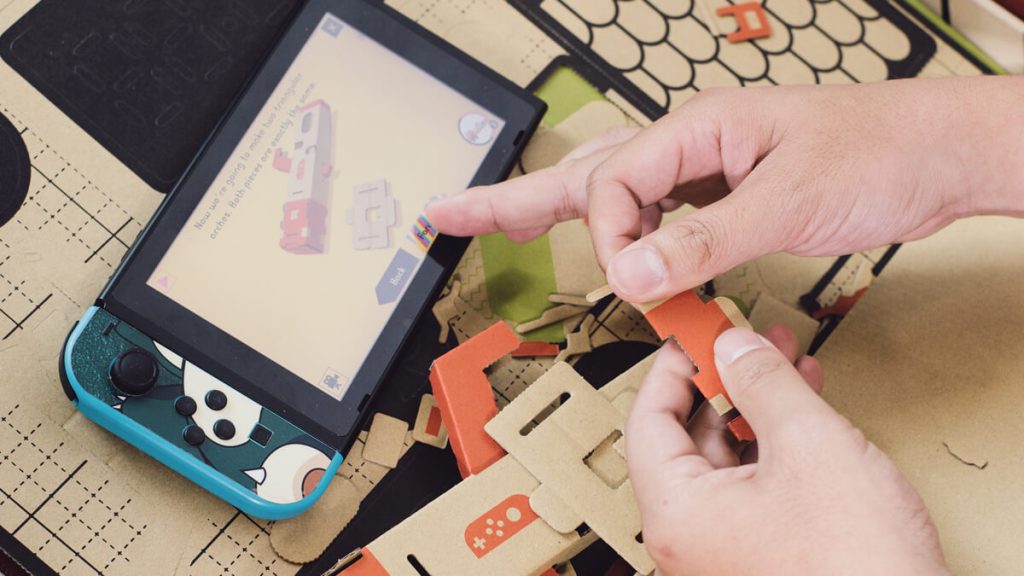When I was a kid, I remember using tape, glue and markers to turn cardboard boxes into race cars, rocket ships and castles. Those boxes and a little imagination went a long way while growing up.
You have no doubt heard the old saying “to think outside of the box.” It usually means to think creatively. But have you ever wondered though how much the box was worth?
The designers at Nintendo have the answer. They believe that audiences would pay anywhere between $70 and $80 for a few cardboard boxes, some rubber bands and stickers. The company calls this Labo.
On April 20th, 2018 the studio expects untold thousands of boxes to fly off the shelves. Labo is essentially an activity kit made out of cardboard, but it requires the owner to have a Nintendo Switch to use.
The Nintendo Switch is a game console (both portable and TV-adaptable) it is also the successor to the Wii U. The system retails for $299 and was the runaway console for 2017. The company sold 10 million units in its first 9 months. Which is an insanely great number for any studio to achieve.
Nintendo President Tatsumi Kimishima hopes to sell an additional 20 million systems by March 2019. Based on their track record they may very well hit that mark.
Back to the Labo: However, Nintendo has created a series of different play modules, called Toy-Con for their kit. Audiences can create a playable piano, fishing game, motorcycle racer or even animated bug robot to use with their Switch and its detachable controllers. The kits include everything a budding creator needs plus video step-by-step instructions that they can watch using the Switch console itself.
Nintendo has done very well in the game industry, as you may know. They have always released games and consoles at their own pace and have never followed the trends from their rivals. The developers working at Nintendo have their pulse on the market and try to create unique experiences.
Traditional game design through the ’80s and ’90s had developers creating the rules, stories and linear paths that audiences had to follow. In the past 20 years, that sort of game design has shifted to an open-ended “sandbox” environment where players have more freedom to explore and find different ways of completing a story.
Games that give you the tools to create your own play experience have really taken off in the past few years. Both the Minecraft and Lego series give their audiences tremendous flexibility and each has sold over 100 million units.
Labo is an entirely new experience. It gives audiences a physical object that they assemble, paint, sticker or decorate any way they want. Once their cardboard project is built, the audience can play however they want with it. Their Switch is now a musical instrument, a remote-control robot or even a virtual reality (VR) box. The player can change out different components and have a different experience each time they play.
Relatively speaking, the $70 or $80 price of entry is not bad compared to how much those individual toys or science kits would cost in a toy store. This is a level of interaction that frankly no other publisher is offering.
I would argue that Labo is the beginning of a new toy trend. Expect to see more inexpensive cardboard or plastic projects that work with a smartphone or game console this holiday season.
Disney is sitting in a mountain of properties that could follow the format or work to license them to Nintendo. If I had a favorite attraction at the theme parks and wanted to enjoy that experience at home, I would gladly pay $70 for a Haunted Mansion or Pirates of the Caribbean Labo kit. Imagine being a pirate riding through the attraction and having the ability to interact with the environment in VR. Get into cardboard sword battles with the Spanish fleet, follow Jack Sparrow on an adventure. Audiences would have the ability to change the outcome of the attraction or even shape their own version with an editor.
I would also gladly pay $80 for an Iron Man virtual reality Labo suit. Star Wars, Marvel, Muppets, Pixar, are all IP could fit the format. The ability to turn those properties into a game is only limited by our imagination.
I can’t wait to get my hands on Labo. What do you think?
